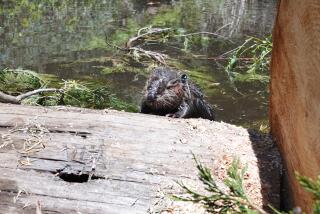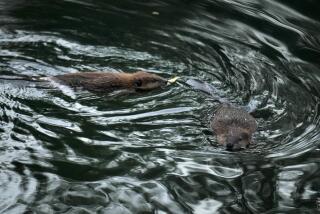Girl Scouts Learning to Trap, Skin Beavers
- Share via
ANCHORAGE, Alaska — Let other Girl Scouts make bird feeders out of Clorox bottles and glue together little birch-bark canoes -- Troop 34 in Alaska is learning to trap and skin beavers.
In a practice that has angered animal rights activists, the girls are killing the beavers as part of a state flood-management program.
“We think it sends a very, very bad message that when animals cause a problem you kill them,” said Stephanie Boyles of People for the Ethical Treatment of Animals. She said the Girl Scouts should want girls to become “stewards of wildlife, not abusers.”
Last spring, about 10 members of the Fairbanks troop and their families helped catch two beavers using snare and lethal traps. The girls were taught how to find the animals’ dens and how to lay the traps. Working under close supervision, the girls used knives to skin the beavers.
The troop had the pelts tanned and plans to make hats and mittens after a dozen hides are collected. The girls also want to cook beaver meat.
They plan to begin setting traps again this month.
Alaska Girl Scout leaders said they know of no other troop in the country to take part in such a program.
Officials at the Girl Scouts’ New York headquarters did not return repeated calls. But in a Sept. 16 letter to PETA, spokeswoman Courtney Shore said the organization does not promote trapping or hunting and does not offer merit badges for those activities.
Shore noted that Troop 34, made up of 13 girls ages 10 to 12, participated after an invitation from the state Department of Fish and Game.
“It is understandable why the troop responded positively when approached by a state authority to conduct an activity that is commonplace in that area of the country,” Shore wrote.
The state-run Take a Kid Trapping program is aimed at controlling flooding and other damage caused by an increasing number of beavers along the lower Chena River in Fairbanks. It is open to children as young as 7.
Alaska scout leaders said the program is a “non-issue” in Fairbanks, where trapping has a long history.
Troop 34 leader Dona Boylan said she wanted to impart lessons in responsible game management to the scouts, who are city girls, at least by Alaska’s standards. Fairbanks is a city of nearly 30,000.
“Trapping may not be pretty, but the girls understand the seriousness and huge responsibility of taking a life,” Boylan said. “They understand that when humans impact their environment, they become ultimately responsible for maintaining a healthy population of the animals they have to coexist with in these urban centers.”
Girl Scout leaders said none of the girls would talk to Associated Press.
“I feel like PETA doesn’t have a concept that trapping is considered a heritage here in Alaska,” said Mike McDougall, a trapper who worked with the scouts. “These kids are learning more than just how to take an animal. They’re learning about ecology. They also got a definite sense of respect for the animals.”
The program is helping to curb a burgeoning population of the large rodents, which in Alaska can weigh up to 70 pounds. Their growing numbers are attributed to recent warm winters and a drop in commercial trapping.
“Beavers are a valuable source of education for our young people,” said Tom Seaton, a Fish and Game biologist. “Their carcasses can be used in many ways -- for food, for warm garments. Almost everything about beavers is good except when they flood your yard or knock down live trees.”
More to Read
Sign up for Essential California
The most important California stories and recommendations in your inbox every morning.
You may occasionally receive promotional content from the Los Angeles Times.













